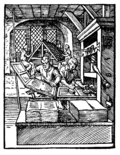Mass production
If an item is produced in large quantities, this is usually called mass production. The item produced is called product, and it is usually made in a factory. The items produced will all be the same type. The process of making large quantities will usually require the use of standardized products or product groups. It also depends heavily on interchangeable parts.[1]
Today, machines are often used to mass produce such items. Using division of labour, a greater number of items can be produced. Adam Smith used the example of a needle: With division of labour, it is possible to produce more needles in the same time. Frederick Winslow Taylor, the father of Taylorism also used the division of labour: he wanted to divide the tasks into planning tasks, and execution.
Mass Production Media
Sometimes production in series has obvious benefits, as is the case with this 5-sickle casting mould from the Bronze Age on show at a museum in Yekaterinburg, Russia.
This woodcut from 1568 shows the left printer removing a page from the press while the one at the right inks the text blocks. Such a duo could reach 14,000 hand movements per working day, printing around 3,600 pages in the process.
CNT-FAI worker cooperative in Barcelona producing wood and steel products
Mass production of Consolidated B-32 Dominator airplanes at Consolidated Aircraft Plant No. 4, near Fort Worth, Texas, during World War II
The assembly plant of the Bell Aircraft Corporation in 1944. Note parts of overhead crane at both sides of photo near top.
References
- ↑ "Mass Production". Willamette University. Retrieved 5 August 2016.







